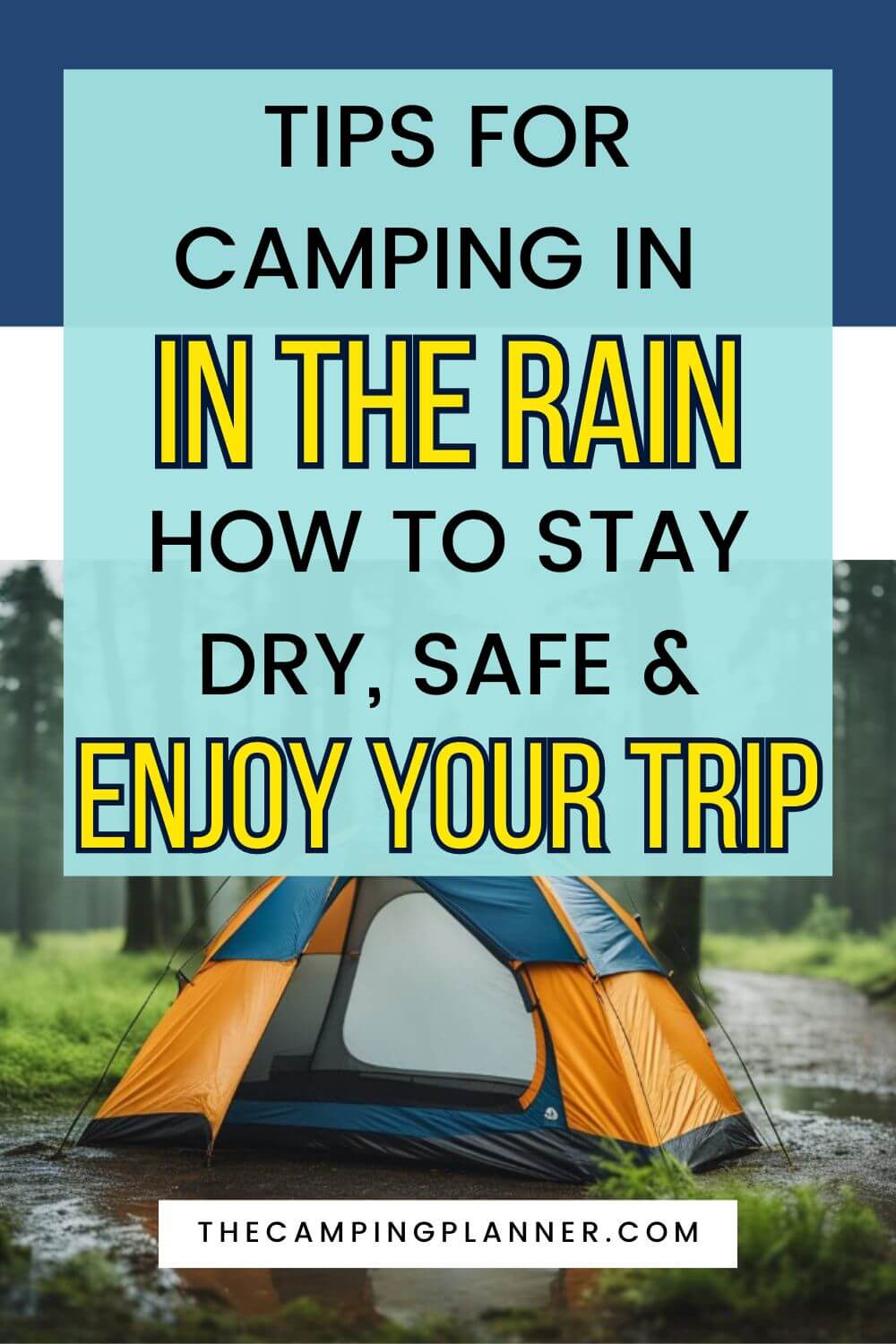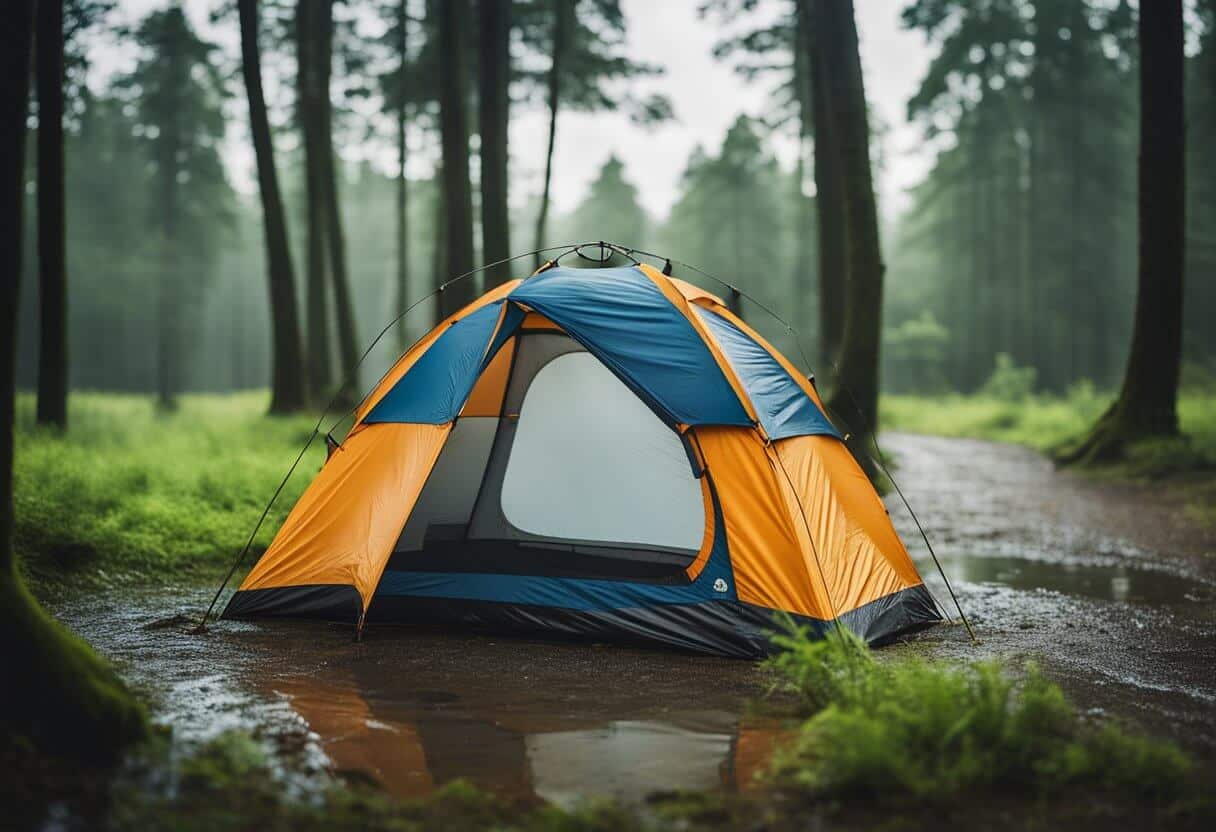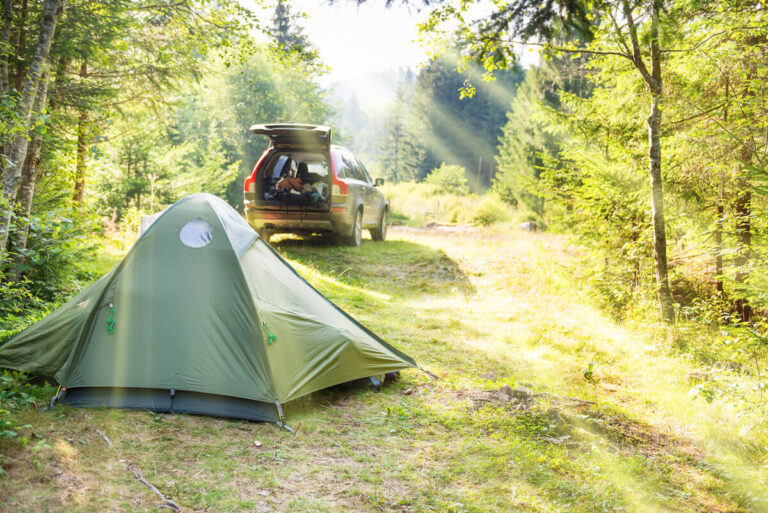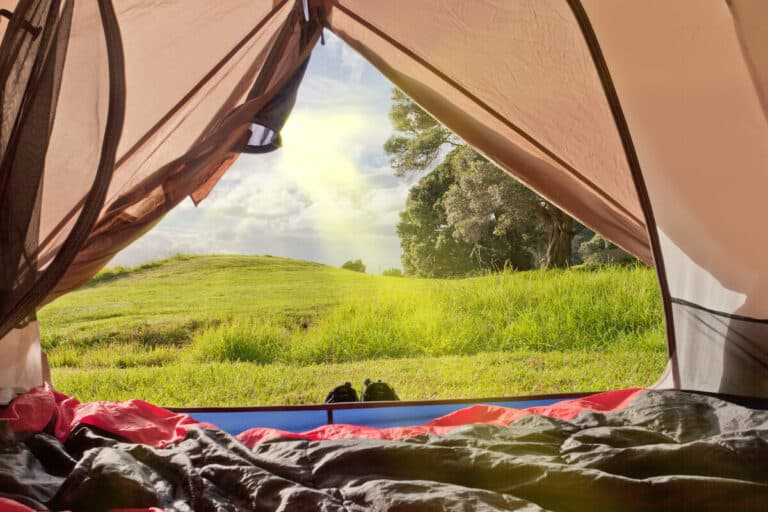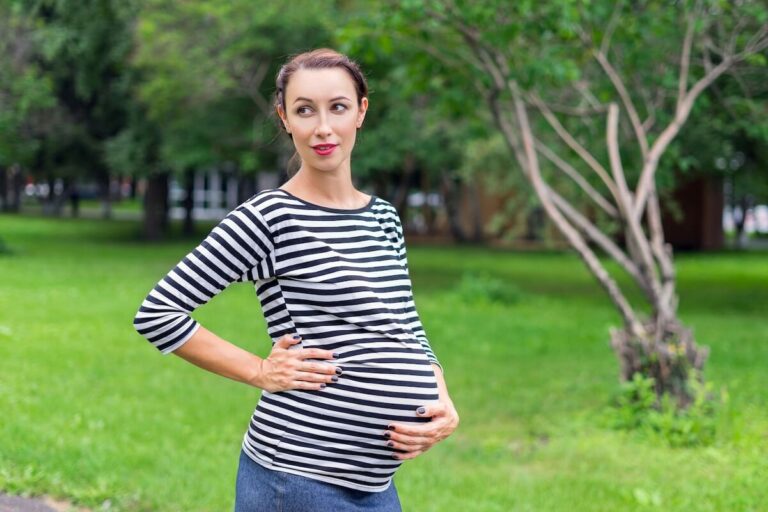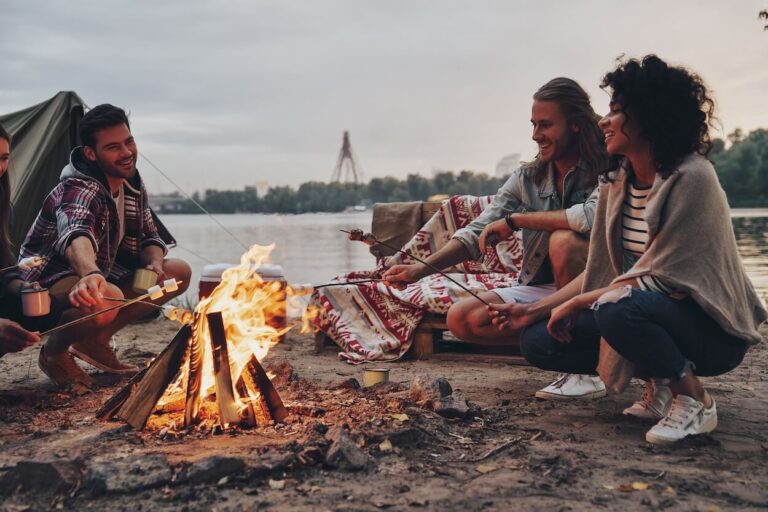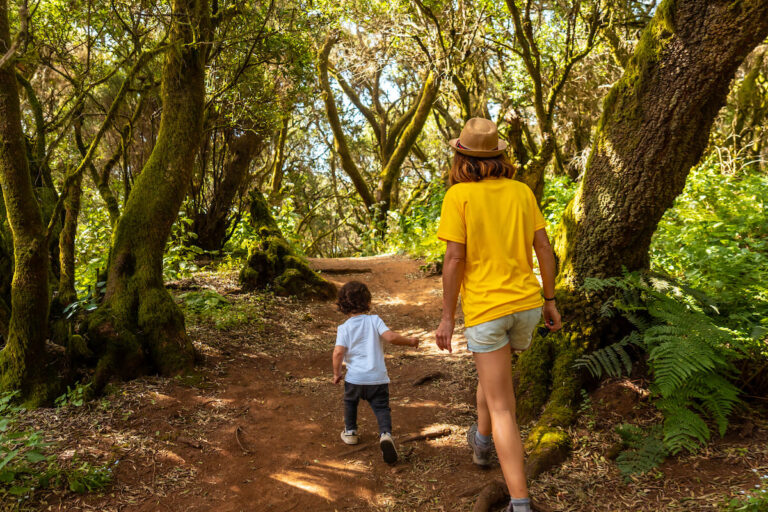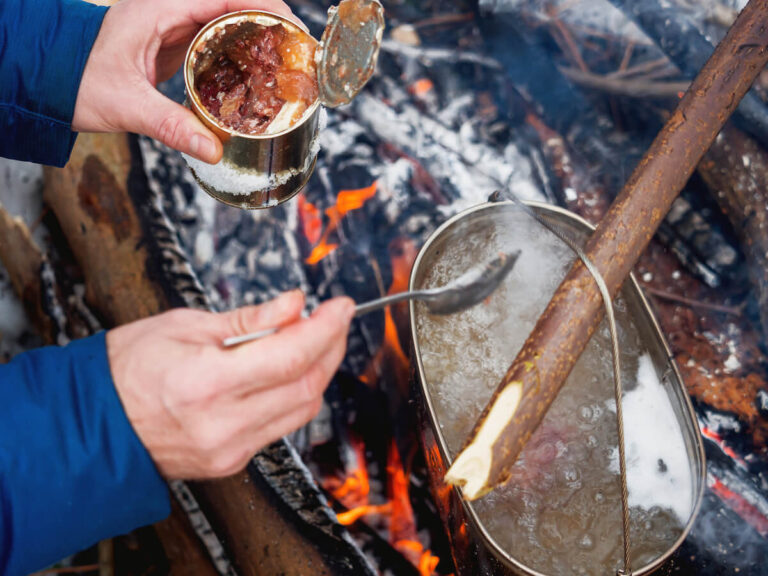Tips for Camping in the Rain: How To Stay Dry, Safe & Have Fun
Planning a camping trip but the weather forecast doesn’t look so great! These tips for camping in the rain will help you make the most of your outdoor adventure – even when it’s not what you hoped for.
Camping is a great way to get outdoors and spend time with friends and family. However, unpredictable weather can put a damper on your plans, especially if it involves rain. But don’t let the forecast stop you from having a fun camping trip! With some preparation and a positive attitude, you can still have a great time camping in the wet weather.
Essential Tips For Camping In The Rain
When it comes to camping in the rain, preparation is key. These rainy camping tips will help make sure you stay dry and still get to make some epic outdoor memories with family and friends.
Here are some essential tips to help you prepare for wet-weather camping:
Essential Gear and Equipment for Wet Weather Camping
Make sure you have the right gear and equipment for camping in the rain. Here are some essential items that you should consider bringing with you:
- All-Weather Tent: Choose a tent that is waterproof and has a rainfly to keep you dry. Look for tents that are labelled as waterproof or have a high water resistance rating. This is essential!
- Tarps: Extra tarps can be used to create additional shelter or cover for your tent or gear. Bring a few extra tarps to stay dry during your trip.
- Door Mat: A door mat can help keep your tent clean by giving you somewhere to wipe your shoes so you don’t track mud and dirt through the tent.
- Rain Gear: A good rain jacket is essential for staying dry in wet weather. Look for gear that is made from waterproof and breathable materials.
- Dry Bags and Sacks: If you’re planning on hiking or backpacking, keep your gear dry by packing it in waterproof bags and sacks. Ziploc bags, dry sacks, and dry bags are all good options.
- First Aid Kit: Make sure you have a first aid kit that is stocked with supplies for treating cuts, scrapes, and other injuries – there are more chances of slips and falls in the rain.
Selecting a Suitable Campsite in Rainy Conditions
Choosing the right campsite can make all the difference when it comes to camping in the rain.
A camping ground that has some facilities can be a more enjoyable experience during a wet weather camping trip too, such as an undercover camp kitchen so you don’t have to do all your cooking outdoors, or toilet and bathroom facilities so you don’t need to set up your own makeshift bathroom in the rain.
Additionally, look for campsites that are on high ground and have good drainage to avoid your campsite becoming flooded.
If you can’t find a suitable campsite with these features, consider setting up your tent on a slight slope so water can run off easily.
Another important consideration is to make sure your tent is not located under any trees or branches that could potentially fall in strong winds.
Choose a location that is sheltered from the wind if possible, such as rock formations or a tree barrier (that’s a safe distance from your tent), to block some of the wild weather.
Importance of Checking Weather Forecasts Before Heading Out
Checking the weather forecast before you head out on your camping trip is essential for preparing for wet weather. The weather can always change unexpectedly, but if you know severe weather is predicted, you can cancel or postpone your trip until a later date.
Otherwise, here are some other considerations why this is a must-do before you head off on any camping trip:
- Safety: Knowing the weather forecast can help you prepare for any potentially dangerous conditions, such as heavy rain or thunderstorms.
- Packing Essentials: If you know it’s going to be wet, you’ll want to pack additional gear like waterproof jackets and extra tarps to keep your campsite dry.
- Planning Activities: Rainy weather can put a damper on certain activities like hiking or swimming, so it’s good to know what to expect and plan accordingly.
- Alternative Destinations: If the weather is looking particularly bad for your intended camping location, having a backup plan can save you from being stuck in a soggy campsite.
Setting Up Camp in the Rain
Camping in the rain can be a daunting experience, but with the right preparation and mindset, it can also still be enjoyable. Here are some strategies and tips for setting up camp in the rain.
Creating a Dry and Comfortable Campsite
Creating a dry and comfortable campsite is essential for an enjoyable camping experience in the rain. One way to do this is by using tarps and rain flies effectively.
A rain fly is a cover that goes over your tent to protect it from rain, while a tarp can be used to create extra shelter for cooking or relaxing outside your tent.
Use tarps to create extra shelter and keep your gear and cooking area dry. Make sure to secure them tightly to prevent them from blowing away in the wind.
If you’re using gazebos, make sure they are secured deep in the ground with proper pegs since they are rather prone to tipping over. They aren’t great for use in strong winds either, as the frame can bend and twist.
Strategies for Pitching a Tent in the Rain
When it comes to pitching a tent in the rain, it’s all about finding the right tent site. As mentioned above when choosing a campsite, look for a spot with higher ground, away from rivers or lakes, to avoid flooding.
When pitching your tent, it’s important to do it quickly and efficiently to minimize exposure to the rain. Consider practising setting up your tent at home before your camping trip, so you can do it quickly and easily in the rain.
Additionally, consider investing in a quality waterproof tent and using seam sealer and waterproofing spray to further protect your tent from moisture.
Additionally, here are some other tips to keep in mind:
- Tarp First: Before setting up your tent, lay down a tarp or groundsheet. This will create an additional barrier between the wet ground and your tent floor.
- Rainfly Placement: Make sure to properly secure your rainfly over your tent. It should overlap the edges by at least a few inches to prevent rain from seeping into your tent.
- Stake Down: Use extra stakes and tensioners to secure your tent and rainfly. This will help prevent water pooling on top of the tent, which can cause leaks.
- Extra Tarp Coverage: If possible, set up an additional tarp over your tent. This provides another layer of protection from the rain and can also create a covered area for cooking or hanging out.
Staying Dry and Comfortable In The Rain
Camping in the rain can be a challenging experience when it comes to staying comfortable. Here are some tips to help you stay warm and dry in wet weather.
Clothing Tips For Rainy Weather Camping
When camping in the rain, it’s important to wear the right clothing to stay dry and comfortable.
Start with a good base layer made of merino wool or synthetic material that wicks away moisture from your skin.
Wear waterproof pants and a rain jacket to keep your upper and lower body dry. Gaiters can also be helpful in keeping water out of your boots.
Pack extra socks and clothes in waterproof bags or plastic tubs, so you can change into dry clothes if necessary.
You may think you won’t need this but if your tent starts to leak, there is nothing worse than having all damp clothing and bedding!
Keeping some of your belongings in the car while car camping can help keep them dry too.
Bring Proper Footwear
One of the most important things to consider when camping in the rain is your footwear. Wear waterproof boots to keep your feet dry and warm. Pack extra socks in case your feet get wet.
You can also get waterproof sneakers if you are still hoping to go for a hike during your wet camping trip. These are a lot more comfortable compared to trying to hike in a pair of gumboots.
Campfire and Cooking in the Rain
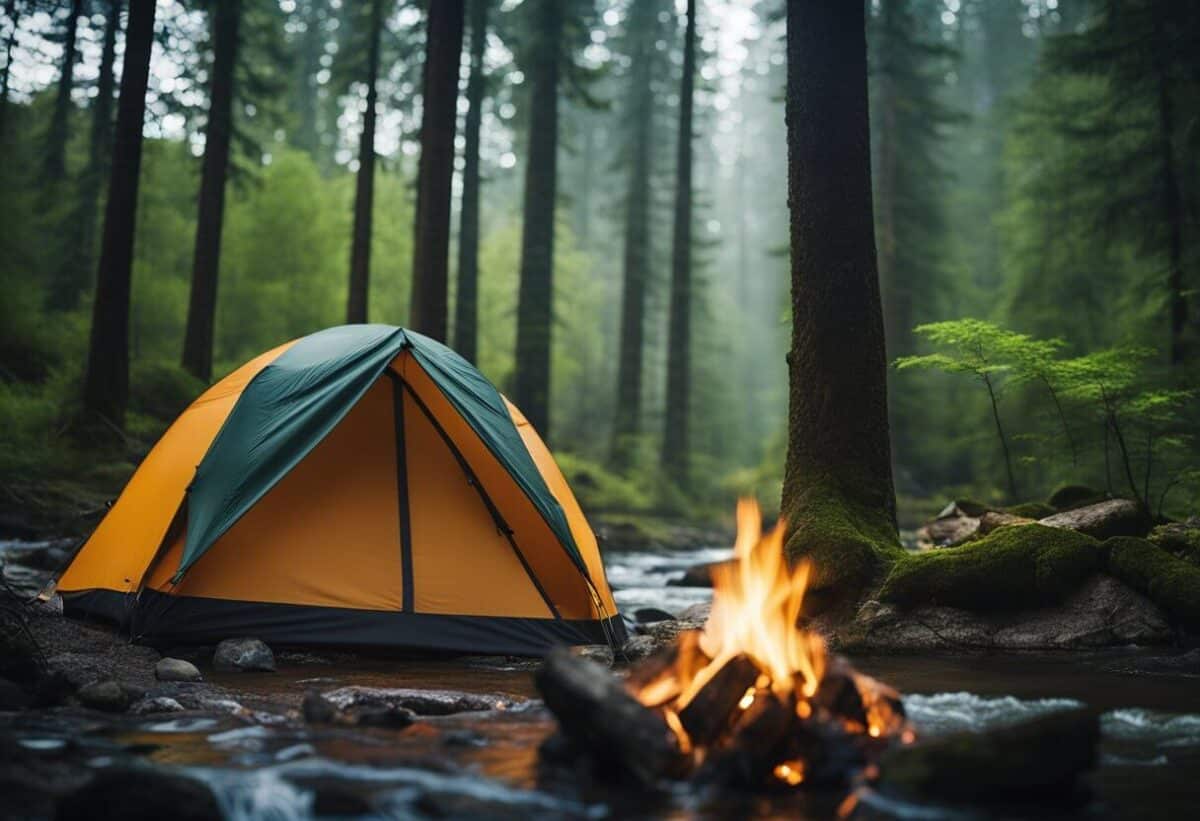
When camping in the rain, building and maintaining a campfire can be challenging. Here are some tips for building and maintaining a campfire in wet conditions:
Tips for Building and Maintaining a Campfire in Wet Conditions
- Bring dry firewood: Wet firewood is difficult to ignite and maintain. You can sometimes collect dry firewood from under trees or use firewood that you brought from home. If you don’t have somewhere dry to keep it, store it under your vehicle so it’s out of the direct rain.
- Use a fire starter: A fire starter can help you ignite the fire quickly and easily. You can use commercially available fire starters or make your own using cotton balls soaked in petroleum jelly.
- Create a base for your fire: To prevent your fire from being put out by soggy ground, create a base using rocks or bricks. This will also help elevate your fire and keep it going longer.
- Keep your fire small: A small fire is easier to maintain than a large one. Therefore, it’s essential to keep your fire small and manageable. This will help you conserve your firewood and reduce the risk of accidents.
Find more tips for starting a fire during wet weather here.
Planning Meals During A Rainy Camping Trip
Cooking meals in the rain isn’t the easiest thing in the world but it can be done! Here are some strategies for cooking meals in the rain:
- Use a propane stove: A propane stove is safe and convenient, especially when a fire is not possible. You can use it to cook meals quickly and easily undercover, even in wet conditions.
- Bring pre-prepared meals: Pre-prepared meals that can be easily heated and enjoyed are ideal for camping in the rain. You can bring canned foods, instant noodles, or pre-cooked meals that require minimal preparation.
- Keep Ingredients Dry: Make sure to keep your ingredients dry by storing them in sealed containers or ziplock bags. This will prevent them from getting wet and becoming unusable.
Safety and Emergency Preparedness When Camping In The Rain
Camping in the rain can present some unique safety challenges. Here are some tips to help you stay safe and be prepared for emergencies:
Importance of Staying Aware of Potential Hazards in Rainy Conditions
When camping in the rain, it’s important to stay aware of potential hazards. Slippery terrain can cause falls and injuries.
Flash floods can occur suddenly, so it’s important to keep an eye on the weather and avoid camping in areas prone to flooding.
Additionally, thunderstorms can produce lightning strikes, which can be deadly. Stay away from tall trees and open fields during thunderstorms and seek shelter in a safe location.
Staying Safe During Thunderstorms and Heavy Rain
If you find yourself in the midst of a thunderstorm or heavy rain, take precautions to stay safe. Stay away from metal objects and tall trees, which can attract lightning.
Seek shelter in a sturdy building or in your vehicle if possible. If you’re camping in the backcountry or wilderness, find a low-lying area and avoid setting up camp on high ground or near water sources.
If you’re caught outside during a thunderstorm, crouch down low and minimise contact with the ground. Stay away from any bodies of water, as they can attract lightning strikes.
Importance of Having a Plan for Emergency Situations
It’s important to have a plan for emergencies when camping in the rain. Make sure you have a first aid kit with you and know how to use it.
If someone in your group suffers from hypothermia or other cold-related injuries, take immediate action to warm them up.
If you’re camping in a remote area, make sure someone knows your itinerary and when you’re expected to return. In case of an emergency, make sure you have a way to call for help, such as a satellite phone or emergency beacon.
Enjoying Rainy Camping Trips
Camping in the rain can be a unique and exciting experience when it’s just a little harmless rain. You can still have a great time despite the wet weather. Here are some tips to help you enjoy your rainy camping adventure.
There are plenty of ways you can make the most of your camping trip even when the weather is poor.
Here are some ways to make your camping trip fun when it’s raining:
- Play board games or card games in your tent
- Bring a good book or e-reader to read while listening to the sound of rain
- Make hot chocolate or warm soup on a portable camping stove
- Take a rainy nature walk and appreciate the beauty of the rainy landscape
- Use tarps and awnings to create sheltered areas for activities like cooking or lounging
- Bring along some musical instruments and have a rainy-day jam session
- Jump in puddles with the kids and embrace your inner child
- Set up a small movie theatre in your tent with a portable projector and screen Use the rain as an opportunity to relax and unwind, without feeling guilty about not doing outdoor activities
- Take advantage of the natural beauty around you. Rainy weather can create some stunning landscapes and photo opportunities
Having some pre-prepared activity like these printable camping games or our camping activity book for kids will also make sure everyone is having fun in the tent!

The importance of Maintaining a Positive Attitude and Being Flexible
Perhaps the most important thing to remember when camping in the rain is to maintain a positive attitude and be flexible.
Rainy days can be unpredictable, and it’s important to be prepared for any changes in the weather. Try not to let the rain dampen your spirits, and instead, focus on the fun and adventure that comes with camping. Remember, a little rain never hurt anyone, and it can even make for some great camping memories.
In summary, camping in the rain can be a fun and exciting adventure. By embracing the experience, finding joy and relaxation despite the wet weather, and maintaining a positive attitude and flexibility, you can have a great time on your rainy camping trip. And if your camping trip is cancelled because it’s far too wet outside, these indoor camping ideas can bring the fun to you!
Essential camping tips for your next camping trip:
